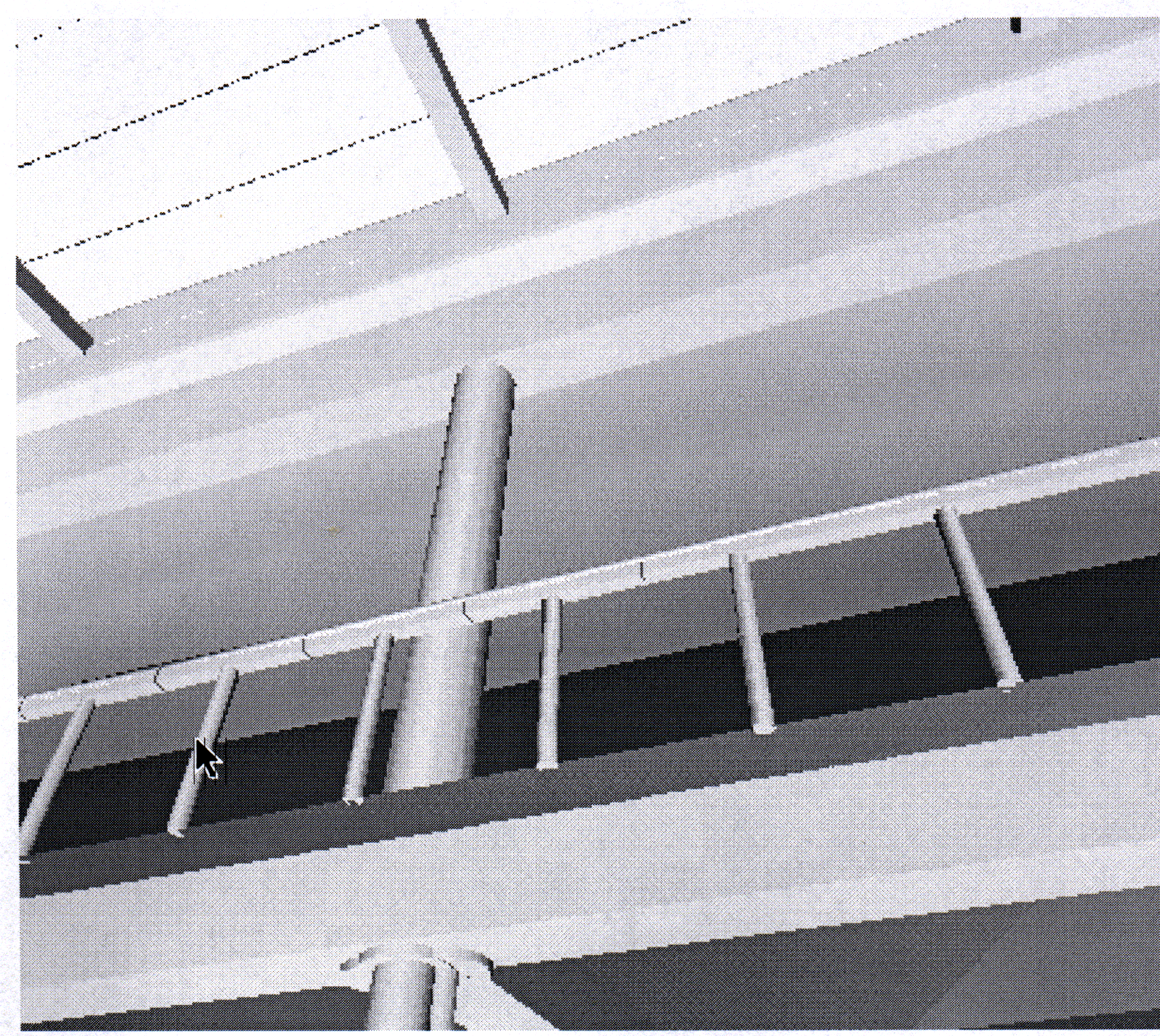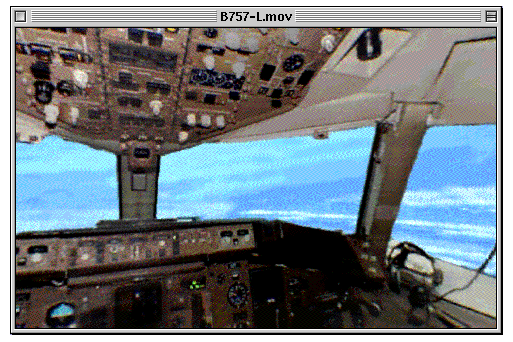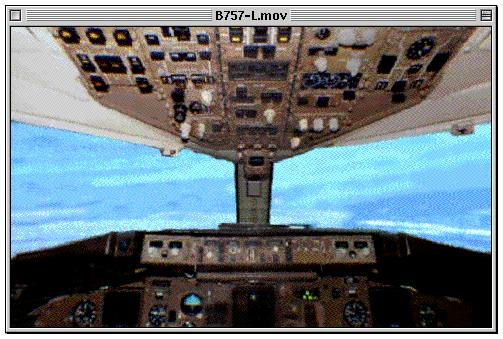

This paper argues that `traditional' Human Computer Interaction (HCI) techniques, such as hierarchical task analysis and iterative development, do not support the design of desktop virtual reality (desktopVR). If this problem is not addressed then users will continue to be presented with superficially pleasing but essentially useless applications of this technology.
DesktopVR creates a huge opportunity for the development of innovative user interfaces. For example, Figure 1 shows how the Virtual Reality Markup Language (VRML) can be used to construct a three dimensional model of a Museum. This enables curators to use virtual space to group multimedia exhibits in the same way that phyiscal positions are used to group objects from the same time period or culture within a conventional museum.


Similarly, Figure 2 shows how the photorealistic renderings of QuicktimeVR can be used to provide a 360 degree view of the interior of a Boeing 757. This application enables fire crews to familliarise themselves with the layout of the aircraft without grounding large numbers of planes during frequent training exercises.


This optimism about the effective use of desktopVR must, however, be balanced against the many applications that provide only limited benefits to their users. For example, the Internet provides literally thousands of VRML models that do little more than illustrate the capabilities of the language. Many applications provide inaccurate models of physical artefacts. Most support only the most trivial of user tasks.
The first problem with conventional task analysis is that it can be difficult for designers to identify the intended user population for a VRML or QuicktimeVR application. The accessibility of desktopVR is often a key motivating factor in the customers' decision to exploit this technology. For instance, the potential users of the virtual Museum in Figure 1 were identified as: school children; curators; computing scientists; historians and archaeologists. The Boeing 757 system of Figure 2 was initially developed for firefighters. It was later proposed as a more general training tool for aircrews, for airline advertising and aircraft maintenance teams. These diverse groups differ in many different ways: learning style; education qualifications; previous exposure to computer systems; average age.
Even if designers agree upon their intended user population, it can be difficult to identify meaningful tasks. For instance, Figure 2 was intended to help members of the Fire Brigade to learn where exits were located on the 757. It is unclear how this high level requirement could be represented within conventional task analysis. The sub-task for browsing the aircraft might trivially be identified as browsing some component of the fuselage. This problem occurs because DesktopVR has opened up new forms of declarative, knowledge acquisition. It provides little or no support for the proceduralised tasks that have dominated previous generations of form and menu based interfaces.
Evaluator: Do you prefer pictures or the models? User: The models are great. Evaluator: Why? User: Um, it just feels different.This analysis is confirmed by the results of post task questionnaires. For example, the following graph presents the results of asking a class of school children for their opinions of QuicktimeVR within a Museum web site. The Y-axis records the number of users responding to a particular category within a checked list. The proportion of children who preferred not to state an opinion is striking.
The questions in Figure 3 were not intended to obtain statistically significant and replicable results. They were simply intended to provide some insight into whether or not the users supported our introduction of desktopVR. The large number of uncommitted responses to such fundamental questions can be extremely disappointing. Gibson provides some insight into the source of this disappointment:
`` Not only do we perceive in terms of visual information, we can also think in those terms. Making and looking at pictures helps us to fix these terms. We can also think in terms of verbal information, as is obvious, and words enable us to fix, classify and consolidate our ideas. But the difference is that visual thinking is freer and less stereotyped than verbal thinking: there is no vocabulary of picturing as there is of saying.'' (Gibson, 1971).
If Gibson is correct then there are important consequences for the iterative development of desktopVR. Users may simply lack the vocabulary to directly participate in the formative evaluation of VRML and QuicktimeVR systems.
Further problems arise if designers attempt to measure more subjective qualities of desktopVR. For example, high levels of motivation and `fun' are often cited as an important strength of this new generation of interactive systems. For example, the activist learning style of most firecrews and the low success rate with conventional `lecture-based' courses was cited as a key reason behind the development of the system illustrated in Figure 2. It can, however, be difficult to identify appropriate means of measuring `fun'. Longitudinal approach are necessary to determine whether high levels of satisfaction are sustained through repeated use of a VRML or QuicktimeVR interface. Unfortunately, previous studies have not conducted prolonged investigations into the subjective appeal of desktopVR (Johnson, 1998).
Contextual design techniques also avoid some of the problems that restrict the utility of task analysis for desktopVR. These techniques assume that designers can seldom predict the full diversity of tasks that users will find for their applications. The identification of these tasks is only possible through the observation of users operating similar tools within their daily lives (Johnson, 1998). Finally, contextual evaluation techniques focus upon the interpretation of an artefact within its working context. Designers are not forced to identify and pursue summative performance measures that provide an impoverished view of desktopVR applications.
The penultimate section of this paper has briefly argued that contextual design techniques avoid the limitations of more `conventional' approaches. They encourage designers to consider heterogeneous user populations with diverse and ill-defined tasks. They focus upon the analysis of an interface within the working environment rather than upon precisely defined statistical measures. Initial attempts to apply these techniques have proved to be very useful for the examples used in this paper. More evidence is required.
The urgent need to develop suitable HCI techniques for both desktopVR applications and their browsers is illustrated by the following excerpt from a think aloud with the Museum site illustrated in Figure 1:
Evaluator: How are you trying to find the exhibit? User: I'm looking for the exhibit from the picture and trying to move towards the area that seems most relevant...this area bears no relation to where I wanted to go....
It is an indictment of HCI research and practice that the user could be be talking about almost any interface to a desktopVR system.
Further discussion of this work is provided here